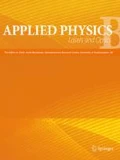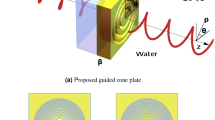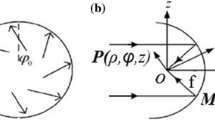Abstract
We theoretically demonstrate that optical focus fields with purely transverse spin angular momentum (SAM) can be obtained when a kind of special incident fields is focused by a high numerical aperture (NA) aplanatic lens (AL). When the incident pupil fields are refracted by an AL, two transverse Cartesian components of the electric fields at the exit pupil plane do not have the same order of sinusoidal or cosinoidal components, resulting in zero longitudinal SAMs of the focal fields. An incident field satisfying above conditions is then proposed. Using the Richard–Wolf vectorial diffraction theory, the energy density and SAM density distributions of the tightly focused beam are calculated and the results clearly validate the proposed theory. In addition, a sub-half-wavelength focal spot with purely transverse SAM can be achieved and a flattop energy density distribution parallel to z-axis can be observed around the maximum energy density point.





Similar content being viewed by others
References
M. Neugebauer, T. Bauer, A. Aiello, P. Banzer, Phys. Rev. Lett. 114, 063901 (2015)
A.Y. Bekshaev, K.Y. Bliokh, F. Nori, Phys. Rev. X 5, 011039 (2015)
M.H. Alizadeh, B.M. Reinhard, Opt. Express 24, 8471 (2016)
S. Saha, A.K. Singh, S.K. Ray, A. Banerjee, S.D. Gupta, N. Ghosh, Opt. Lett. 41, 4499 (2016)
W. Zhu, V. Shvedov, W. She, W. Krolikowski, Opt. Express 23, 34029 (2015)
P. Banzer, M. Neugebauer, A. Aiello, C. Marquardt, N. Lindlein, T. Bauer, G. Leuchs, J. Eur. Opt. Soc. Rapid 8, 13032 (2013)
J. Chen, C. Wan, L. Kong, Q. Zhan, Opt. Express 25, 8966 (2017)
O.G. Rodríguez-Herrera, D. Lara, K.Y. Bliokh, E.A. Ostrovskaya, C. Dainty, Phys. Rev. Lett. 104, 253601 (2010)
A. Aiello, P. Banzer, M. Neugebauer, G. Leuchs, Nat. Photonics 9, 789 (2015)
Y. Zhao, J.S. Edgar, G.D.M. Jeffries, D. McGloin, D.T. Chiu, Phys. Rev. Lett. 99, 073901 (2007)
C. Kuang, X. Hao, X. Liu, T. Wang, Y. Ku, Opt. Commun. 284, 1766 (2011)
H. Wang, L. Shi, B. Luƙyanchuk, C. Sheppard, C.T. Chong, Nat. Photonics 2, 501 (2008)
W. Han, W. Cheng, Q. Zhan, Appl. Opt. 54, 2275 (2015)
W. Han, Y. Yang, W. Cheng, Q. Zhan, Opt. Express 21, 20692 (2013)
B. Richards, E. Wolf, Proc. R. Soc. Lond. A Math. Phys. Sci. 253, 358 (1959)
D.B. Ruffner, D.G. Grier, Phys. Rev. Lett. 111, 059301 (2013)
A. Aiello, P. Banzer, J. Opt. 18, 085605 (2016)
A. Aiello, P. Banzer, arXiv:1502.05350 (2015)
Author information
Authors and Affiliations
Corresponding author
Appendix
Appendix
-
1.
Detailed expression of det (\(A|\overrightarrow {{E_{o} }} (\theta ,\varphi )\)) = 0:
$$\left\{ \begin{aligned} \varPhi_{1,2a} = \varPsi_{2,2b} = \varPhi_{3,2c + 1} (\forall a,b,c \in N) \hfill \\ \varPhi_{1,2a + 1} = \varPsi_{2,2b + 1} = \varPhi_{3,2c} (\forall a,b,c \in N) \hfill \\ \varPsi_{1,2a} = \varPhi_{2,2b} = \varPsi_{3,2c + 1} (\forall a,b,c \in N) \hfill \\ \varPsi_{1,2a + 1} = \varPhi_{2,2b + 1} = \varPsi_{3,2c} (\forall a,b,c \in N) \hfill \\ \sin \theta (f_{11} + g_{21} ) = 2\cos \theta f_{30} \hfill \\ \sin \theta (2f_{10} + f_{12} + g_{22} ) = 2\cos \theta f_{31} \hfill \\ \sin \theta (g_{12} + 2f_{20} - f_{22} ) = 2\cos \theta g_{31} \hfill \\ for\;n = 2,3,4 \cdots \hfill \\ \sin \theta (f_{1,n - 1} + f_{1,n + 1} - g_{2,n - 1} + g_{2,n + 1} ) = 2\cos \theta f_{3,n} \hfill \\ \sin \theta (g_{1,n - 1} + g_{1,n + 1} + f_{2,n - 1} - f_{2,n + 1} ) = 2\cos \theta g_{3,n} \hfill \\ \end{aligned} \right..$$(A1) -
2.
Electric field and SAM density corresponding to \(\vec{E}_{i} (\theta ,\varphi )\) in Eq. (12):
Rights and permissions
About this article
Cite this article
Hang, L., Fu, J., Yu, X. et al. Generation of a sub-half-wavelength focal spot with purely transverse spin angular momentum. Appl. Phys. B 123, 266 (2017). https://doi.org/10.1007/s00340-017-6841-5
Received:
Accepted:
Published:
DOI: https://doi.org/10.1007/s00340-017-6841-5




